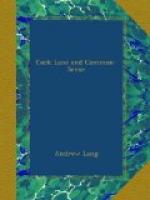The very same remarks apply to ‘Crystal-Gazing’. Folklore welcomes it in legend or in classical or savage divination. When it is asserted that a percentage of living and educated and honourable people are actually hallucinated by gazing into crystals, the President of the Folklore Society (Mr. Clodd) has attributed the fact to a deranged liver. {0d} This is a theory like another, and, like another, can be tested. But, if it holds water, then we have discovered the origin of the world-wide practice of crystal-gazing. It arises from an equally world-wide form of hepatic malady.
In answer to all that has been urged here, anthropologists are wont to ejaculate that blessed word ‘Survival’. Our savage, and mediaeval, and Puritan ancestors were ignorant and superstitious; and we, or some of us, inherit their beliefs, as we may inherit their complexions. They have bequeathed to us a tendency to see the viewless things, and hear the airy tongues which they saw and heard; and they have left us the legacy of their animistic or spiritualistic explanation of these subjective experiences.
Well, be it so; what does anthropology study with so much zest as survivals? When, then, we find plenty of sane and honest people ready with tales of their own ‘abnormal’ experiences, anthropologists ought to feel fortunate. Here, in the persons of witnesses, say, to ‘death-bed wraiths,’ are ‘survivals’ of the liveliest and most interesting kind. Here are parsons, solicitors, soldiers, actors, men of letters, peers, honourable women not a few, all (as far as wraiths go), in exactly the mental condition of a Maori. Anthropology then will seek out these witnesses, these contemporary survivals, these examples of the truth of its own hypothesis, and listen to them as lovingly as it listens to a garrulous old village wife, or to an untutored Mincopi.




